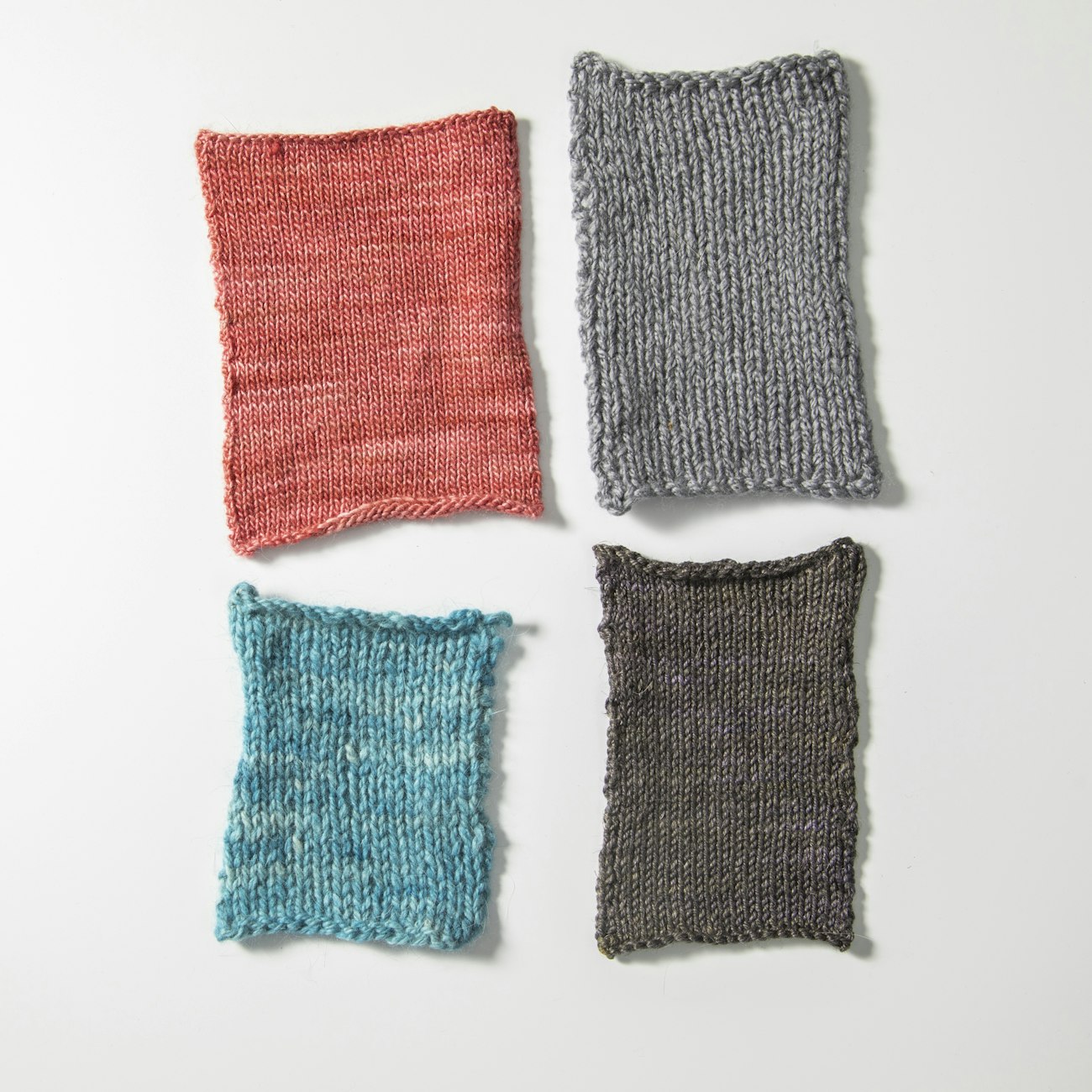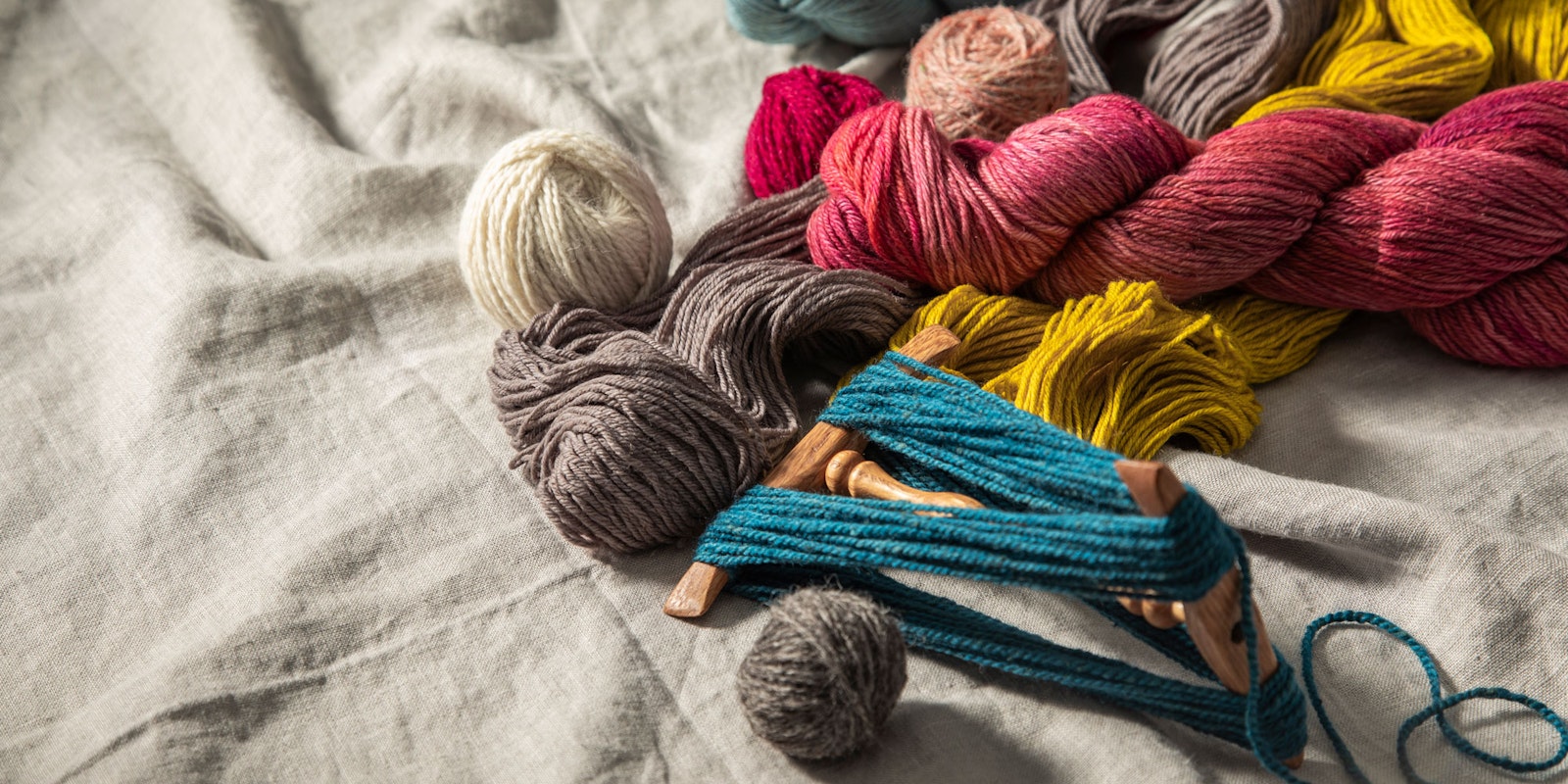Subscriber Exclusive
How Much Yarn Is Enough? Part 1: Weigh Your Yarn Before You Cast On
Before you commit to a new knitting project, make sure you won't run out of yarn an inch from the end. Here's one method to estimate yarn requirements for knitting projects.
Before you commit to a new knitting project, make sure you won't run out of yarn an inch from the end. Here's one method to estimate yarn requirements for knitting projects. <a href="https://farmfiberknits.com/how-much-yarn-is-enough-part-1-estimating-by-weight/">Continue reading.</a>
https://farmfiberknits.com/cdn-cgi/image/format=auto/https://www.datocms-assets.com/101500/1691862240-230802ffk23-239-header.jpg?auto=format&w=900
Imagine yourself holding several skeins of yarn and wondering if you have enough to knit a sweater. Or perhaps reaching into a bag of lovely fiber that you’d like to spin and knit and wondering how much yarn it takes to make a scarf.
One way to proceed is just to start knitting and hope for the best. Sometimes things turn out fine. Other times you end up with quite a lot of yarn left over, but you can always save it for the future. Now and then, you run out of yarn before you finish the project and have to do some creative problem-solving.
But perhaps you’d like to know in advance that your yarn supply is adequate for the project you have in mind. You don’t have to wait until you’re done knitting. Before you start, you can make rough estimates of yarn requirements by weight. Or you can make more specific estimates by measuring a sample swatch. Measuring and figuring does take a little more thought and time at the beginning of a project, but you’re rewarded by the confidence you feel as you begin to knit.
This two-part series walks you through ways to know in advance if you have enough yarn on hand for the project you have in mind. In this first part, you'll learn how to make rough estimates of yarn requirements by weight and how to make more specific estimates by measuring a sample swatch. In part two, you'll learn another method: estimating yarn requirements by area.
Using Weight to Make Rough Estimates
The quickest way to estimate yarn requirements for a project is by weight. Find something similar to the article you want to make (a sweater, a scarf, mittens, an afghan, or whatever) and weigh it. (Or find one described in a magazine or book and look for information on how much it weighs.) That weight is a rough estimate of how much yarn you will need. For example, if you want to knit a size 12 long-sleeve cardigan sweater,
SUBSCRIBER EXCLUSIVE
Imagine yourself holding several skeins of yarn and wondering if you have enough to knit a sweater. Or perhaps reaching into a bag of lovely fiber that you’d like to spin and knit and wondering how much yarn it takes to make a scarf.
One way to proceed is just to start knitting and hope for the best. Sometimes things turn out fine. Other times you end up with quite a lot of yarn left over, but you can always save it for the future. Now and then, you run out of yarn before you finish the project and have to do some creative problem-solving.
But perhaps you’d like to know in advance that your yarn supply is adequate for the project you have in mind. You don’t have to wait until you’re done knitting. Before you start, you can make rough estimates of yarn requirements by weight. Or you can make more specific estimates by measuring a sample swatch. Measuring and figuring does take a little more thought and time at the beginning of a project, but you’re rewarded by the confidence you feel as you begin to knit.
This two-part series walks you through ways to know in advance if you have enough yarn on hand for the project you have in mind. In this first part, you'll learn how to make rough estimates of yarn requirements by weight and how to make more specific estimates by measuring a sample swatch. In part two, you'll learn another method: estimating yarn requirements by area.
Using Weight to Make Rough Estimates
The quickest way to estimate yarn requirements for a project is by weight. Find something similar to the article you want to make (a sweater, a scarf, mittens, an afghan, or whatever) and weigh it. (Or find one described in a magazine or book and look for information on how much it weighs.) That weight is a rough estimate of how much yarn you will need. For example, if you want to knit a size 12 long-sleeve cardigan sweater,[PAYWALL] you might pull one out of the closet and find that it weighs about 24 ounces. To knit a similar sweater, you’d need about 24 ounces of yarn.
The key word here is similar. Even if they’re the same size, sweaters knitted from thinner or thicker yarns require different weights of yarn. The thinner the yarn, the lighter the knitted article. The thicker the yarn, the heavier the knitting. Knitted from yarn that measures 30 wraps per inch, a size 12 sweater might use as little as 12 ounces of yarn; the same size sweater might require 36 ounces of yarn that measures 10 wraps per inch. Compare the diameter of the yarn in your skeins with that in the sample article that you’re weighing and adjust your weight estimate up or down accordingly.

Estimating by weight: These four swatches show the same weight of yarn—5 grams. Clockwise from top left, merino/silk singles, wool chainette, merino/linen/silk blend, and alpaca. Photo by Matt Graves
For this exercise, we'll look at four different yarn samples.
The pink swatch was knitted on size 2½ (3 mm) needles, is 5" x 4", and used about .25 grams of yarn per square inch. The light gray swatch was knitted on size 9 (5.5 mm) needles, is 5¼" x 2¾", and used about .33 grams of yarn per square inch. The dark gray swatch was knitted on size 3 (3.25 mm) needles, is 5" x 3¼", and used about .32 grams of yarn per square inch. The teal swatch was knitted on size 6 (4 mm) needles, is 4¼" x 3½", and used about .34 grams of yarn per square inch. Measuring by weight, thin yarn goes farther than thick.
Other factors affect weight, too. Some fibers are denser, hence heavier, than others. A sportweight-size yarn of alpaca or mohair is usually a little heavier than the same size yarn of wool. Some yarns are denser than others. A tightly twisted worsted yarn is heavier than the same size of soft woolen yarn.
And this is very important: think about the knitting itself. Packing stitches close together (by knitting tightly or using small needles) uses more yarn, and thus makes a heavier product, than leaving some air space between the stitches (by knitting loosely or using large needles). Knitting in a pattern stitch that makes a thickly textured three-dimensional surface uses more yarn than knitting in smooth, flat stockinette stitch. Fair Isle or patterned knitting, where extra colors are carried along inside the work, uses more yarn than solid-color knitting.
Now you see why going by weight only gives a rough estimate of how much yarn is enough! However, it’s better than no estimate at all, and it only takes a minute to get out the scales and compare the weight of yarn you have with the weight of something you’d like to make.
Choosing the Right Size Needles
I’m going to detour here and tell you about something that caught my attention recently. I used to be lazy about sampling. I’d spin some yarn, try knitting on whatever seemed like the “right” size needles, and pretty much accept the results. Oh, sometimes, if the knitting felt way too tight or too loose, I’d try needles one or two sizes larger or smaller than I’d started with, but that’s all.
I had a way of rationalizing this careless attitude, too. It came from reading the labels of millspun knitting yarns and patterns for using those yarns and learning to equate certain yarn sizes with certain knitting gauges. For example, I thought of worsted-weight yarn as giving 5 stitches to the inch. Indeed it can, but it can also knit up at 4 stitches/inch or 6 stitches/inch, or any fraction in between, depending on what size needles you use. From any yarn you choose, you can knit fabrics that are loose, “normal,” or tight. Gauge depends on the needles as much as on the yarn.
This is important, so I’ll keep going. More than once, back when I thought I was so smart that I didn’t have to sample (ha!), I threw good-as-new, unworn, handspun, and handknit sweaters into the Goodwill box, because I was frustrated with how they had turned out. Some were loose and saggy that I knitted on too-big needles, others were tight and unyielding that I knitted on too-small needles. In either case, I blamed the yarn, or even the fiber, for the sweater’s shortcomings, instead of blaming myself for not taking time to choose the right size knitting needles. Now wasn’t that wasteful? nstead of “A stitch in time saves nine,” I needed to realize that “A swatch in time saves the sweater.”
At least I know I’m not alone. Looking at other spinners’ handknitted articles, one of my most frequent observations is that the knitting is a little too tight or too loose; that is, that the needle size wasn’t just right. Here’s an area where we can all make some progress!
Now let me recommend an exercise that will convert even the most stubborn anti-sampler. Get a ball of yarn and get out all your knitting needles. Start with what you think of as big thick needles; I use size 10, but you might use size 13 or whatever. Cast on about 30 stitches and knit an inch in stockinette stitch (or the pattern stitch of your choice). Change to the next smaller size needles (I use a row of purling to mark the transition) and knit another inch. Change again, and keep going until you’ve gotten to the skinniest needles you can bear using; I go down to size l or 0, but you might stop at size 4. Cast off and block your swatch. (If it’s wool, just press it lightly with the steam iron.)
 This swatch shows the effect of needle size on knitting gauge. Each purl row marks a change to the next size needle.
This swatch shows the effect of needle size on knitting gauge. Each purl row marks a change to the next size needle.
Now look at what you’ve done. See how much wider the swatch is at the cast-on end (knitted on big needles) than on the cast-off end (knitted on small needles)? But it’s the same number of stitches throughout, right? Obviously the gauge changes with needle size. Now feel each section of the swatch and notice how it varies from one end to the other. Perhaps different sections suggest different uses: tighter knitting for durable socks or windproof mittens, or looser knitting for a sweater that drapes nicely. Knowing that you create these different effects with the same yarn gives you welcome flexibility: if you don’t have enough yarn to make a sweater, you might knit on smaller needles and make socks, instead.
Rita's second method—estimating yarn requirements by area—takes longer, but it gives more accurate estimates than a simple comparison of weights. Learn about this method in part two of the series.
Rita Buchanan was associate editor of Spin Off in the 1990s. Now retired, she uses handspun exclusively for her many knitting, weaving, and hooking projects.



 This swatch shows the effect of needle size on knitting gauge. Each purl row marks a change to the next size needle.
This swatch shows the effect of needle size on knitting gauge. Each purl row marks a change to the next size needle.